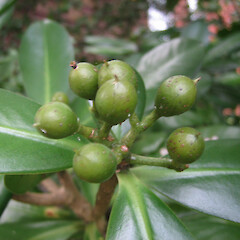Elingamita johnsonii
Common name
Elingamita
Synonyms
None
Family
Primulaceae
Flora category
Vascular – Native
Endemic taxon
Yes
Endemic genus
Yes
Endemic family
No
Structural class
Trees & Shrubs - Dicotyledons
Chromosome number
2n = 46
Current conservation status
The conservation status of all known New Zealand vascular plant taxa at the rank of species and below were reassessed in 2017 using the New Zealand Threat Classification System (NZTCS) – more information about this can be found on the NZTCS website. This report includes a statistical summary and brief notes on changes since 2012 and replaces all previous NZTCS lists for vascular plants.
Please note, threat classifications are often suggested by authors when publications fall between NZTCS assessment periods – an interim threat classification status has not been assessed by the NZTCS panel.
- Conservation status of New Zealand indigenous vascular plants, 2017 . 2018. Peter J. de Lange, Jeremy R. Rolfe, John W. Barkla, Shannel P. Courtney, Paul D. Champion, Leon R. Perrie, Sarah M. Beadel, Kerry A. Ford, Ilse Breitwieser, Ines Schönberger, Rowan Hindmarsh-Walls, Peter B. Heenan and Kate Ladley. Department of Conservation. Source: NZTCS and licensed by DOC for reuse under the Creative Commons Attribution 4.0 International licence.
2017 | At Risk – Naturally Uncommon | Qualifiers: CD, IE, St
Previous conservation statuses
2012 | At Risk – Naturally Uncommon | Qualifiers: CD, IE, OL
2009 | At Risk – Naturally Uncommon | Qualifiers: OL, IE
2004 | Range Restricted
Brief description
Small tree with dark green glossy leaves bearing conspicuous red round fruit inhabiting the Three Kings Islands. Leaves 10-18cm long, leathery, widest towards tip, small pale dots visible when held up against the light. Fruit around 17mm wide, in tight clusters.
Distribution
Endemic. Three Kings Islands where it is known only from West Island and two nearby rocky islets in the Princes Group.
Habitat
Pohutukawa (Metrosideros excelsa) forest and coastal shrub on West island, where it is usually an understorey shrub or small tree. Also grows in exposed places as a canopy emergent, especially on Hinemoa Rock in the Princes Group.
Detailed description
Stout, mostly dioecious tree up to 8 m tall (usually much less). Branches ascending, initially fleshy to sub-succulent, soon becoming woody. Bark grey, smooth (finely lenticellate). Leaves on stout, succulent, coriaceous petioles up to 10 mm long; lamina rigidly coriaceous, 100-200 x 40-190 mm, dark glossy green above, pale beneath, obovate to broadly obovate, margins entire, midrib conspicuous, side veins evident. Inflorescences terminal, paniculate up to 60 x 60 mm, enlarging in fruit; bracteate with bracts shedding as inflorescence matures. Flowers with valvate sepals. Male flowers yellow to yellowish -pink, 4-6-partite, corolla longer than sepals (3-6 x 1.0-1.5 mm), narrowly obovate to broadly oblong. Filaments longer than corolla; anthers elliptic, pollen yellow to yellow-orange. Female flowers pale yellow to pink bearing rudimentary or rarely functional stamens, corolla shorter than sepals, 2.5 x 1-1.5 mm, adnate, shortly oblong to tubular, dehiscing after flowering as a ring. Ovary ovoid, tapered into a stout style. Fruit a globose to subglobose, drupe up to 20 mm diameter, bright red with white flesh. Seed single, enclosed within a brittle subcoriaceous grey-brown to greyish-white endocarp.
Similar taxa
None - the unusual, greyish, almost turgid trunks and stems, dark green, glossy, entire leaves and large grape-like bunches of red, fleshy fruit are very distinctive.
Flowering
February - May, sometimes also August - November
Flower colours
Red/Pink, Yellow
Fruiting
Fruit take a year to ripen so can be present at anytime
Propagation technique
Easy from seed - though this can take up to a year to germinate. Cuttings are slow to strike. Seedlings grow very rapidly and do best in semi-shade, though once established plants thrive in full sun. A fertile, free-draining soil is recommended. This species is predominantly dioecious, so male and female plants are needed to ensure that the attractive grape-like bunches of red fruit are produced. An excellent small specimen tree for the garden. However, very sensitive to cold and frost.
Threats
Currently not threatened but the entire world population occupies a rather small area on one rocky island and two very small adjacent rock islets. These habitats are currently rodent-free. So the species remains vulnerable to stochastic events, fire, and as the fruit is very palatable rats.
Cultural Use/Importance
The tree takes its name from its originally discovery on West Island, the island that was hit by the steamer the ‘Elingamite’. The red, fleshy fruit are edible, the flesh tasting somewhat like an oily, salty apple.
Notes on Taxonomy
Elingamita is one of New Zealand’s endemic, monotypic genera. Its relationship to other genera of the Primulaceae has yet to be properly established.
Attribution
Fact Sheet prepared by Peter J. de Lange (17 July 2004).
NZPCN Fact Sheet citation
Please cite as: de Lange, P.J. (Year at time of access): Elingamita johnsonii Fact Sheet (content continuously updated). New Zealand Plant Conservation Network. https://www.nzpcn.org.nz/flora/species/elingamita-johnsonii/ (Date website was queried)















